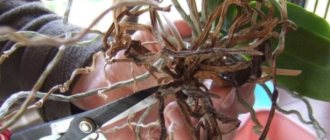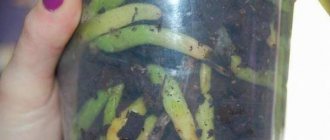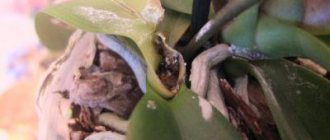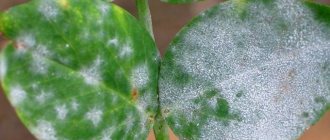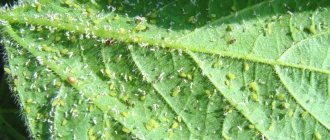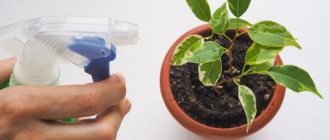Signs indicating illness
If the epiphyte is healthy, then its roots are dense and smooth, and have a grayish-green color.
The following signs may indicate the disease::
The leaves became less elastic and became softer.- Darkening and drying of aerial roots.
- The plant became unstable and swaying.
- There is a coating of spores on the inner walls of the pot.
All these are early signs of putrefactive diseases of orchids. With initial resuscitation efforts, the flower can be brought back to life. But first it’s worth finding out why the orchid began to die.
What parts of the plant may be affected?
Often the rotting process extends to the core, leaves or root system.
Leaves
Leaf rotting develops as a result of improper watering. Most often, orchid leaves are affected by the fungus Pythium . Typically, rotting begins at the base of the plant, after which the roots are affected. This process is rapid, the plant can die in literally 2-3 days. With Phytophthora fungus, the leaves become covered with brown dark spots. Wet rot inhibits plant development. High humidity and high air temperatures lead to this state of the flower.
At the base
If, during watering, water gets into the core of the flower (resembling a funnel), then with high humidity, high temperatures, poor lighting and other circumstances, the process of rotting of the trunk begins.
Rotting processes are most often caused by diseases such as fusarium rot, gray rot, leaf spot, powdery mildew, and viral diseases.
Root
The root rots due to improper watering . This is the main reason among all those considered. In second place is a rare orchid transplant. Old soil does not allow air to pass through to the root system, and moisture stagnation occurs there. And as a result, the root of the plant rotted.
We invite you to watch a video about what the affected plant looks like and what are the reasons for its infection:
Bacterial diseases
Bacterial diseases manifest themselves as leaf spots or rot.
Rot is a more insidious disease. It is sometimes confused with frostbite or swelling because wet, yellow-brown or clear spots form on the leaves.
Not only the leaves are affected, but also the roots and stems. The plant emits an unpleasant odor, and rotting spots are sometimes wet.
Such plants must be isolated and treated according to the identified disease.
Bacterial spot
The disease actively develops when lighting is too bright, improper watering and fertilizing.
The first symptom of infection is yellowness on the leaf blades along the edges. Gradually, the leaves become dark, lose their shape, and become covered with cracks. Weeping areas appear in places where bacteria accumulate.
Fusarium
This type of rot causes the rapid death of an infected orchid. The provoking factors of the disease are stuffy conditions combined with waterlogging.
The leaves gradually turn yellow, then curl and lose their shape. In the late period of the disease, a pinkish tint appears on them.
Black rot
Black rot fungus most often affects orchids. Typically, spores settle on young plants. The provoking factor is infection of the plant by insect pests.
Symptoms of black rot are asymmetrical spots of a dark brown or black hue. As the fungus multiplies, the orchid completely darkens, dries out and dies.
Photo
The photo shows what black and gray rot looks like on orchids.
What are the reasons?
Always at the beginning of putrefactive processes in an orchid flower, it is necessary to find out the reason for this circumstance. Then it will be clear what means to treat for black or gray rot.
There are several reasons for rotting:
- Lack of sunlight, when moisture evaporates poorly and water stagnates in the soil.
- Grinding the soil, due to this it becomes dense and heavy, in this case the moisture also evaporates poorly, the water stagnates.
- If the root area is damaged during transplantation, infection can penetrate through such wounds.
- Orchid infection by a fungal disease.
- Another reason why your flower began to rot is an overdose of chemical fertilizers when feeding the flower, as a result the plant receives a chemical burn.
- An attack on an orchid by click beetles that feed on the root system of the plant.
Often such problems occur in the autumn-winter period; it is at this time that it is important to reduce the number of waterings of the plant, but inexperienced gardeners continue to do this. As a result, the orchid rots.
Under natural conditions, the orchid grows in places with frequent tropical rainfall . Rainwater does not contain as many heavy elements and salts as are present in groundwater, and then flows out of taps in apartments.
Such water can burn the root system of orchids, as can too much chemical fertilizer.
As a result, the roots burn, and this causes rotting processes.
How to prevent domestic orchids from becoming infected with gray mold
It is better to prevent any disease than to suffer later, choosing the right method of treatment. That is why it would be useful to remind flower growers of the need for quarantine for newly acquired plants. While the orchid adapts to the conditions of the new home, its owner will have the opportunity to observe whether troubles in the form of pathogenic microflora or fauna have arrived with it.
It is very easy to bring spores of the fungus Botrytis cenerea into the house on clothes or with unwashed hands after visiting the greenhouse. They are also easily transmitted by air. Regular inspection of your collection will allow you to timely detect an unexpected guest, no matter who he is - an insect pest, a mite or a pathogen.
It is also important to recall that gray rot fungus affects weakened orchids kept in improper conditions with insufficient care. Sometimes, even for a perfectly placed plant, minor mistakes in care are made, leading to the appearance of Botrytis cenerea.
For example, it is advisable to carry out all water procedures in the cold season of the year in the morning, or at least in the first half of the day, so that by the evening the plants have time to dry out sufficiently. Do not allow water to get on the flowers or inside the rosette. If this happens, you need to thoroughly blot off any remaining moisture with a dry paper napkin.
What to process?
Chemicals
How to treat an orchid, including gray and black rot, using chemicals? Often an orchid gets sick due to various pests . Chemical agents will help restore health to your favorite flower.
But you should not use these substances in too large quantities; they should be used carefully and within reasonable limits. You should try to choose drugs with a low (class 3-4) danger threshold.
When purchasing medicines for orchids, you should always follow the instructions that come with the product.
The most popular chemical preparations for plants are:
- "Fitoverm".
- "Inta-Vir".
- "Aktara".
- "Confidor".
More toxic substances that are used for serious diseases of orchids include:
- "Vertimek".
- "Karbofos".
- "Aktellik".
Folk
Traditional methods of combating orchid diseases can also be effective; it is worth considering the most effective of them.
Soap solution .
1 tbsp dissolves in 1 liter of water. liquid soap. Other options are also suitable - grated laundry soap or even dishwashing liquid. This solution treats the entire surface of the flower, especially the leaf parts.- Tobacco infusion .
30-40 g of tobacco is poured into 1 liter of water. The mixture should sit for 24 hours, and it should be stirred periodically. A day later, the tobacco liquid is filtered and the orchid is sprayed with it. - Onion infusion .
A small onion is rubbed through a grater, and the resulting mush is poured with boiling water. The product is left untouched for 7 hours. After this, you need to treat the plant with this mixture for 3-4 days.
Methods of prevention and treatment
To reduce the risk of infection you need to follow simple recommendations:
- When planting, use clean pots . You should not plant or replant an orchid in a container that has previously been used for another plant. First, you need to disinfect it with fungicides. Better yet, get a new pot.
To plant (transplant) orchids, it is better to use new pots specifically designed for them. Old containers may contain pathogens.
- When watering , make sure that water does not get from one phalaenopsis to another.
- When spraying, use a fine spray and do not apply too much water to the surface of the leaves. They shouldn't be wet for too long.
- Ensure free air movement around adjacent plants. To do this, they are positioned so that their leaves and aerial roots do not touch each other.
Tip #1 . When providing aeration, artificial turbulence must not be created, for example, from the flow of a fan or air conditioner. It is also important to protect orchids from drafts. Changes in air flow weaken the plants and they will not be able to resist infection.
Do not arrange orchids too closely. This impedes the free access of air and promotes infection of plants from each other.
- Use fertilizers containing calcium . They are recommended to be applied in the spring.
As soon as there is even the slightest suspicion that an orchid is infected, it is immediately set aside separately from other plants and subjected to therapeutic treatment.
- First of all, you need to stop the spread of infection . To do this, cut off all parts on which symptoms of the disease are found. Removal is carried out down to living tissue.
When working with an infected plant, use only sterile instruments. After each cut, the knife blade must be treated with an antiseptic, for example, alcohol or chlorhexidine. To avoid transferring infection from one plant organ to another
Z. K. Klimenko – head. Department of Ornamental Crops of the Nikitsky Botanical Garden.
- They examine the cut , and if suspicious inclusions are found, for example, small brown dots, then remove another part until they get an absolutely clean surface, without mucus and stains. In case of severe infection, it is sometimes useful to cut out even part of the rhizome. After this, dry naturally, placing it in a dry, well-ventilated place.
- When the cut dries , the orchid is treated with protective agents. Not only the cuttings are sprayed, but the entire plant as a whole.
Treating an orchid for black rot is quite difficult. It's better to prevent infection. To do this, immediately after planting, the plant is watered with a fungicide solution, which can prevent infection. Read more about drugs against putrefactive fungi.
Step-by-step instructions on what to do if certain parts of the flower are rotten?
Sheet
If rot appears on the leaves, this means that some problem needs to be eliminated. For example, in winter, remove the plant away from the battery.
But there should be enough daylight in the room. You need to check the orchid tray, perhaps moisture has accumulated there. Bordeaux mixture or fungicide is suitable for spraying leaves. Regular feeding with complex fertilizers for orchids is also important.
Root
What to do if the root of a plant begins to rot? You need to remove the plant from the pot and remove all dead and rotten roots. They can be recognized by their brown, gray or yellow tint. Diseased roots are cut off along the living part, otherwise the rot will begin to spread further. The cut areas are treated with brilliant green or activated carbon solution .
If most of the roots have been removed, then the plant is immersed in warm and well-filtered water. You need to change the water every day, and you need to dry the root well. The room itself should be well lit, and the air temperature should be within 25 degrees.
Trunk and peduncle
If the trunk and peduncle rot, how to save them?
The trunk and peduncle usually begin to rot earlier than other parts of the flower . Therefore, measures should be taken immediately. It is necessary to immediately treat the soil and root system with a 0.3% foundation solution or a 0.2% benlate mixture. Most often, the orchid is completely immersed in this substance. This is not done often, approximately every 2 weeks.
We invite you to watch a video about treating orchids for rot:
Viral diseases
Viral diseases often cause the death of orchids, since an effective way to combat them has not yet been discovered.
It will not be possible to completely cure an orchid; it is only possible to keep it for some time in conditions where the viral infection does not manifest itself and is inactive.
At a minimum, the orchid needs to be isolated, and at maximum, destroyed. The virus may not appear for a long time.
The orchid must be isolated to avoid cases of infection. Viruses manifest themselves on both flowers and leaves.
The most famous viral disease is when mosaic spots appear on the leaves of an orchid.
The disease progresses as follows:
- Starts with small light yellow dots.
- Gradually the spots become larger and darker.
- Small swellings appear.
- Over time, the spots are pressed in and the leaves are “eaten away.”
Symptoms vary from virus to virus, so an accurate diagnosis can only be determined in a laboratory.

